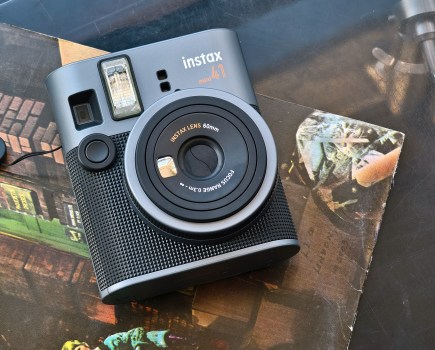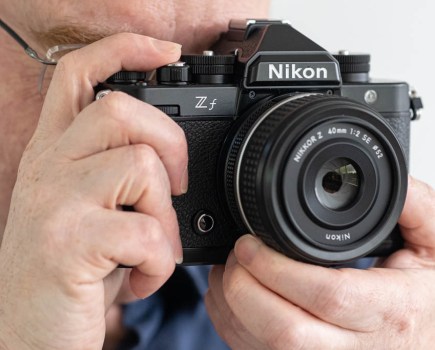Between 1976 and 1982, Canon made six SLR cameras (single lens reflexes – SLRs): the Canon AE-1, AE-1 Program, AT-1, A-1, AV-1 and AL-1.
They were distinguished by their different exposure modes, and most, though not all, were available with either chrome or black bodies.
Because of its name and the fact that it incorporated all the modes used individually in the other cameras, it might be assumed that the Canon A-1 was the first, from which the others were derived. Not so.
The Canon AE-1 was first, and it was an immediate success, with sales of more than 4,000,000 in its first five years. Like the other five A-series cameras it also has a lot to offer to today’s film user.

Canon EA-1 shutter-priority camera. Credit: John Wade
1976: Canon AE-1
Before the AE-1, Canon SLRs were made of metal, heavy and bulky. But in 1972, Olympus had set a new lighter, more compact style of SLR with the OM-1. Other major manufacturers raced to compete, and the AE-1 was Canon’s answer. Its design and production were revolutionary.
The bottom plate was traditionally stamped out of brass, but the top-plate was formed from lightweight injection-molded plastic, plated with multiple metal layers and finished with chrome. This enabled Canon to produce a lighter, more complex design at an otherwise impossible price.
Most priority-exposure systems of the time went for aperture-priority, in which the photographer sets the aperture, then automation selects and sets the correct speed. This route was taken because it was easier to automate an electronic shutter than to produce an electronic system for mechanically adjusting apertures. Many photographers, however, understood the concept of shutter speeds more easily than the theory behind apertures. So the AE-1 was planned as a shutter priority model, where the photographer sets the shutter speed, then the automation sets the appropriate aperture.
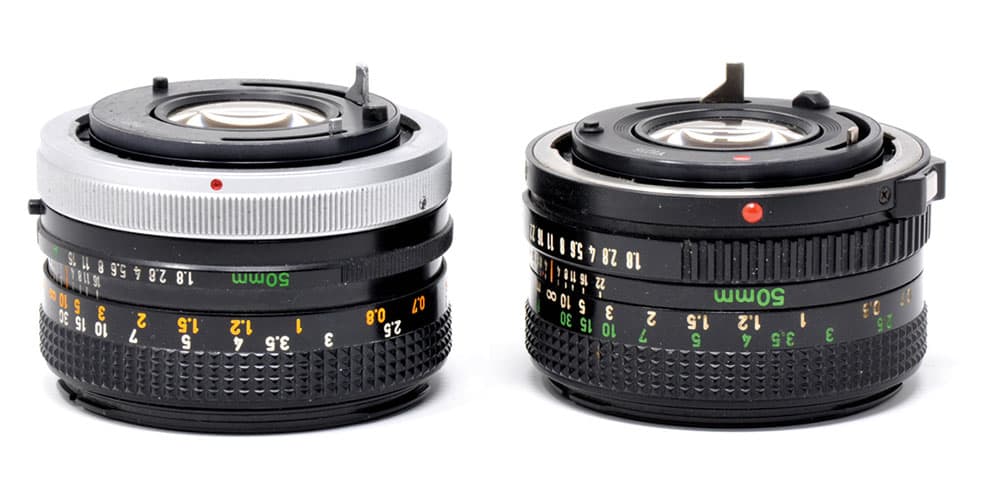
The early breech-lock lens mount (left) and the newer FD bayonet mount, both usable with Canon A-series SLRs. Credit: John Wade
The AE-1 was the first to incorporate a central processing unit (CPU) to handle functions that included metering, exposure, memory, warning signals and safety mechanisms. The system was driven by a 6-volt, PX28 battery. Today’s equivalents can be found on Amazon. The downside is that the camera will not function without a battery. The upside is that the batteries last well.
For today’s film photographer, operation is simple. With the aperture scale on the lens set to ‘A’, a shutter speed is selected on the top-mounted dial and first pressure taken on the electromagnetic shutter release. This turns on the through-the-lens metering and a needle against a scale in the viewfinder indicates the automatically selected aperture. A split-image rangefinder aids focusing, then the shutter release is pressed all the way to make the exposure. With the aperture scale switched away from its ‘A’ setting the camera can be used manually, with the viewfinder scale suggesting (rather than actually setting) the required aperture. A shutter lock, delayed action and depth of field indication button complete the specification.
Models that followed were variations on the AE-1 design.

Credit: John Wade
Canon AV-1
Launched 1979
Guide price £20-50*
Despite Canon’s preference for shutter priority, aperture priority was prominent among the company’s rivals – and it soon transpired that many users also favoured it. Enter the Canon AV-1, another AE-1 look-alike, but this time without a shutter speed dial. In its place, there is a control marked 1/60 second for fl ash sync, ‘B’ and ‘Auto’. Setting an aperture manually automatically sets the correct shutter speed in a stepless range, which is displayed on a scale in the viewfinder.
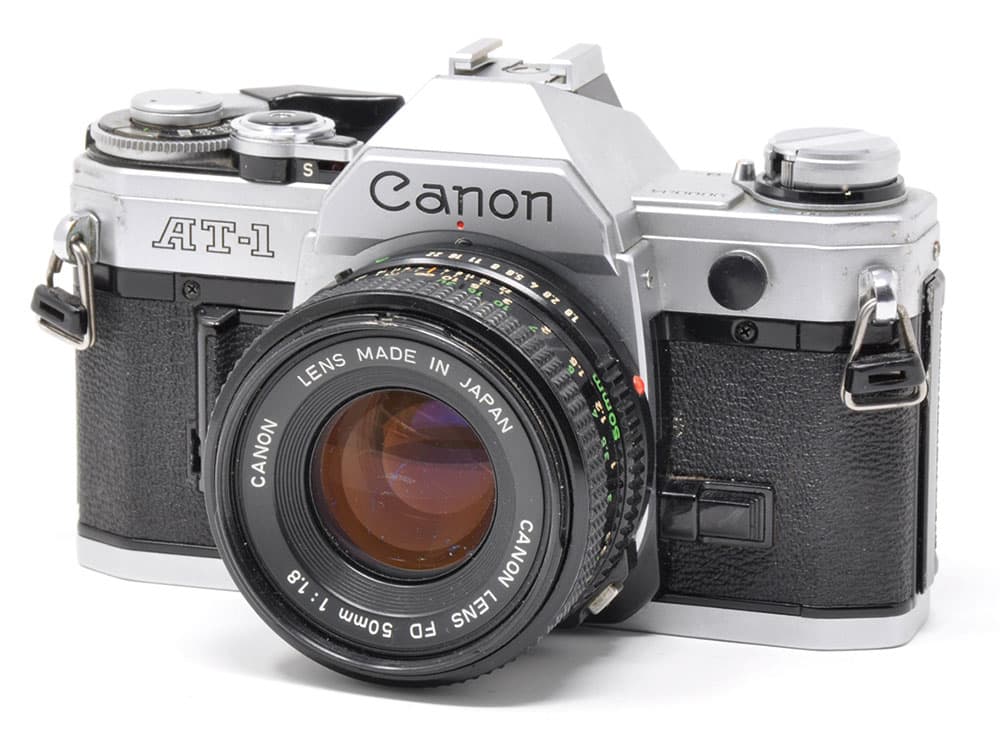
Credit: John Wade
Canon AT-1
Launched 1976
Guide price £30-50*
The AT-1 is similar to the AE-1, but without shutter priority automation, or the aperture scale in the viewfinder. In its place a circular indicator moves as apertures are adjusted to line up with a moving needle activated by the meter. When the two meet, correct exposure has been set, but the photographer is free to override it.
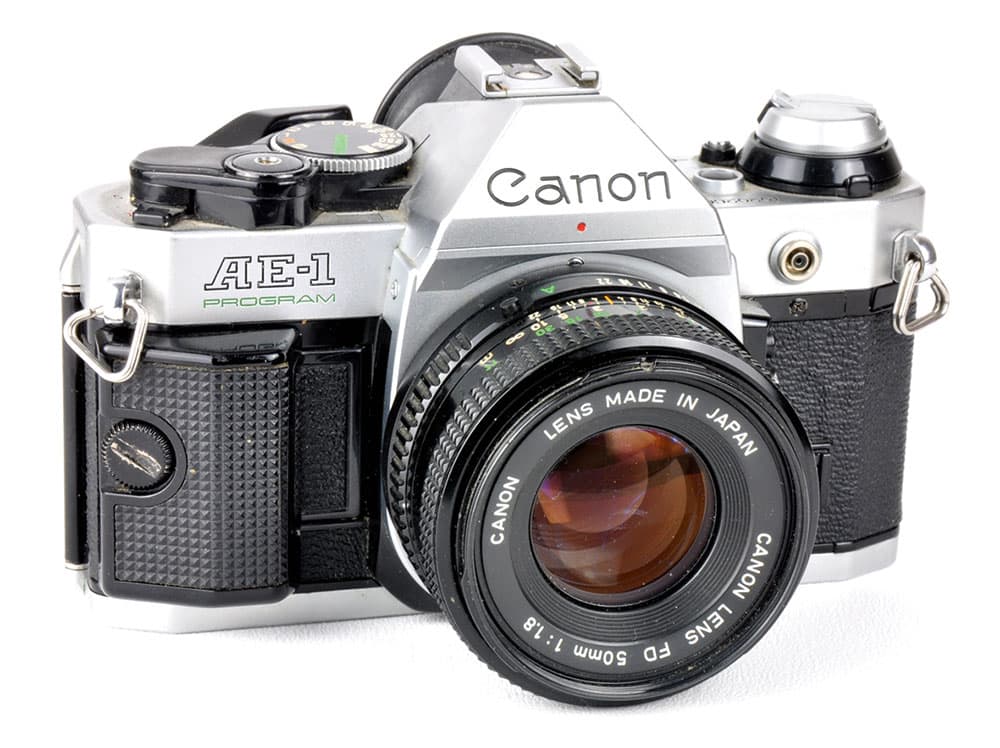
Credit: John Wade
Canon AE-1 Program
Launched 1981
Guide price £75-120*
Here’s a camera that does everything its name suggests. It’s a shutter-priority AE-1 with the addition of programmed automation. The extra exposure mode is selected on the shutter speed dial, with the lens aperture turned to its ‘A’ setting.
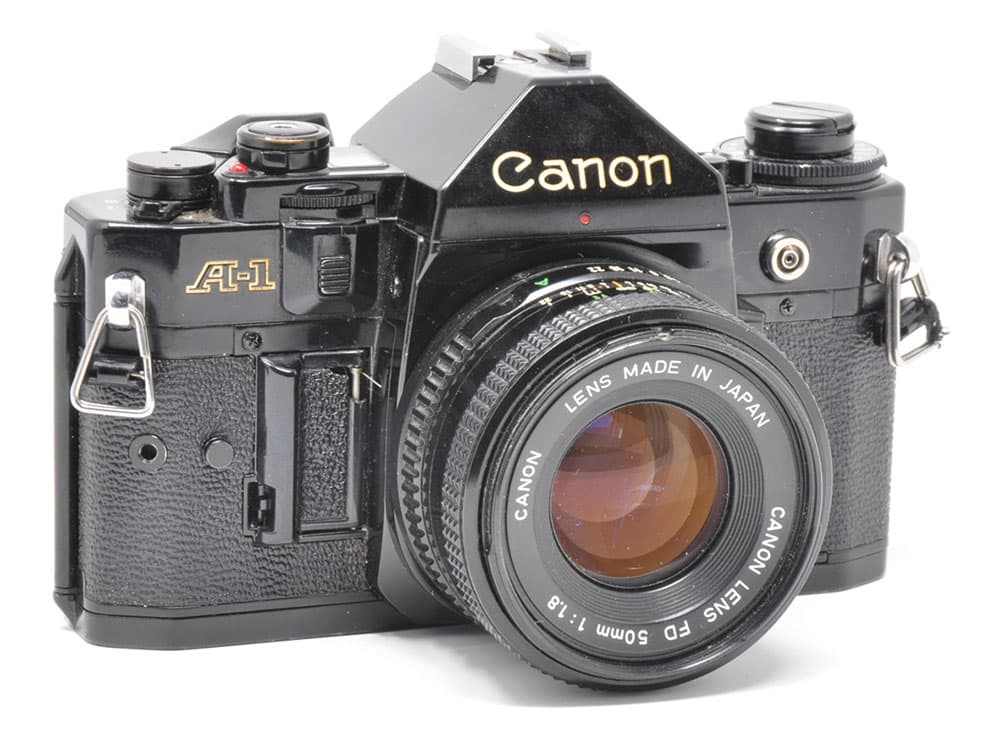
Credit: John Wade
Canon A-1
Launched 1978
Guide price £120-150*
The most advanced of the A-series was the first camera to offer programmed automation in which both shutter speeds and apertures are automatically selected and set. Four further exposure modes include shutter priority, aperture priority, stopped-down AE and manual. Shutter speeds run from 1/1,000 second down to a full 30 seconds. Both the shutter speeds and apertures are set by a thumbwheel on the front of the body. When set for shutter priority, speeds appear in a window beside the shutter release. Set for aperture priority, the scale in the window changes to show apertures.
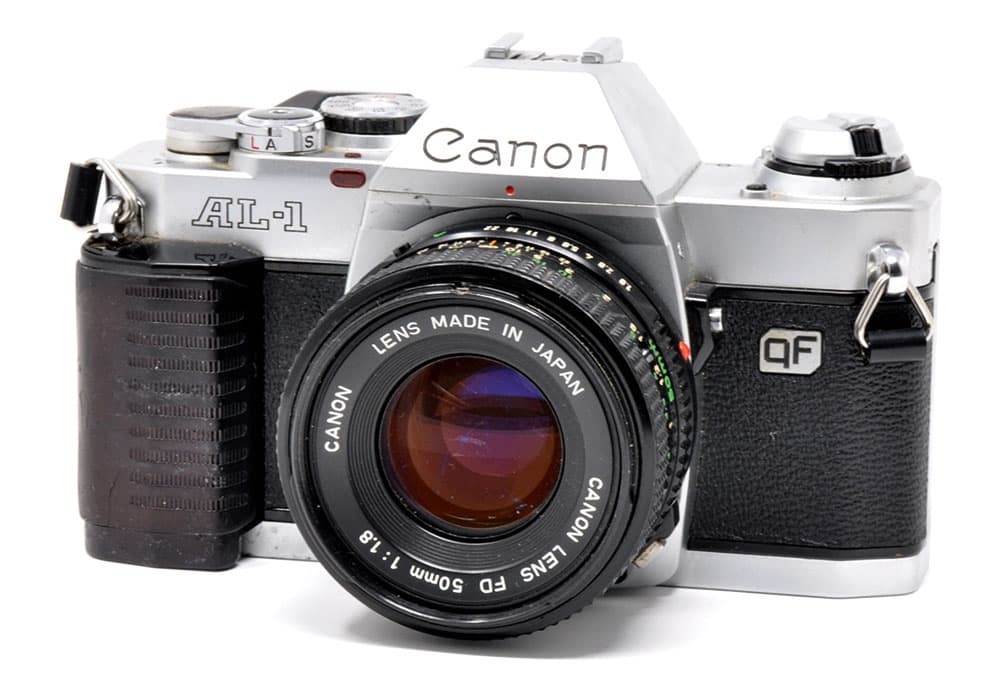
Credit: John Wade
Canon AL-1
Launched 1982
Guide price £20-40*
This is an aperture-priority camera like the AV-1, but adds Canon’s QF (for Quick Focus) function. Three charge coupled devices (CCDs) receive a portion of the lens’s image via a pattern etched into the semi-silvered reflex mirror. When the correct point of focus is identified as the spot where image contrast is at its peak, a message is passed to three light-emitting diodes (LEDs) at the base of the viewfinder. Red LED arrows tell the photographer which way to turn the focusing ring on the lens until a central green LED lights to indicate correct focus. The AL-1 is the only A-series camera to use AAA batteries.
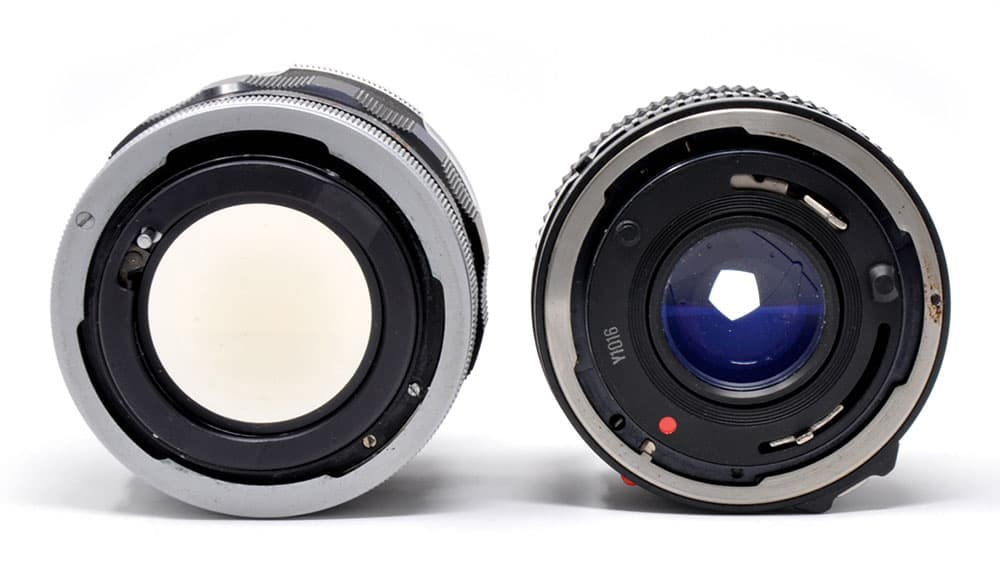
A Canon FD lens (right) allows full aperture metering. The FL lens (left) needs the lens to be stopped down before measuring exposure. Credit: John Wade
Lenses and accessories
All six A-series cameras take Canon’s huge and prestigious range of FD lenses which were introduced for the Canon F-1 in 1971. The company’s previous FL lenses, which date back to 1964, can also be used, but only in stopped-down metering mode. Three standard 50mm FD lenses are available with maximum apertures of f/1.2, f/1.4 and f/1.8.
The FL lenses and early FD lenses use a breech-lock mount, in which the lens is offered to the body and a ring around the rear edge turned to lock it into position. With the arrival of the AV-1 in 1979, the FD mount was changed to a more traditional twist and click bayonet. They range from a 7.5mm fisheye to a 1200mm super-telephoto. A vast range of lenses in the FD breech-lock mount can be found from all the major independent makers too.
The unusual FD 35-70mm f/1.4 AF also fits the A-series. Introduced in 1981 this was one of the earliest autofocus lenses. As the focusing mechanism is integral to the lens itself, the autofocus function can be used on any manual-focus Canon FD mount body. Accessories made to fit A-series cameras include flashguns (or Speedlites in Canon parlance), power winders, motor drives, macro and micro close-up devices, databacks, viewfinder adapters and even an underwater capsule.

The Canon FD 35-70mm autofocus lens mounted on a Canon A-1. Credit: John Wade
Choosing and using
- For action photography, choose the AE-1 or AE-1 Program.
- For landscape photography, or if depth-of-field control is important, choose the AV-1.
- For point-and-shoot simplicity coupled with a high-tech specification, go for the A-1.
- For complete manual control with metered assistance, choose the AT-1.
- Remember that you cannot test the camera unless it has a battery on board.
- Be aware that FD lenses will not stop down when they are removed from the camera.
- To test the aperture stop-down of an off-camera FD lens, insert the end cap, then very slightly turn the bayonet mechanism and remove the cap. The stop-down lever will then operate the aperture.
*Guide prices with 50mm F/1.8 lenses. Average prices based on recent Ebay sales






